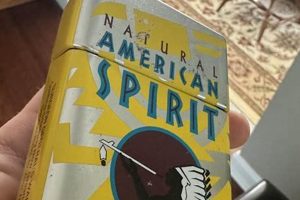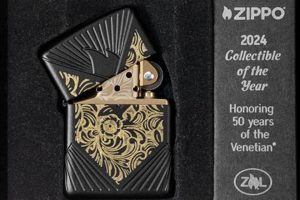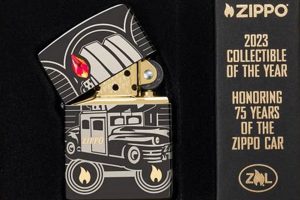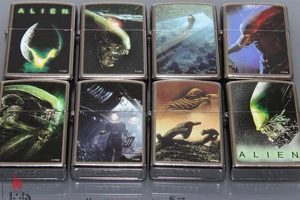Accumulating Zippo lighters as a hobby often involves seeking specific models, designs, or those commemorating particular events. For example, a collector might focus on lighters with military insignia, those representing specific decades, or limited-edition releases. These curated assemblages can range from a few prized possessions to extensive, cataloged collections.
The practice offers enthusiasts a tangible connection to history, art, and manufacturing. Vintage lighters can provide glimpses into past eras, reflecting popular culture, design trends, and historical events. Furthermore, the craftsmanship and variety of finishes, from high-polish chrome to intricate engravings, transform these functional items into miniature works of art. Building a curated set can be a rewarding pursuit, fostering community among collectors and preserving a piece of material culture. The inherent durability of these lighters also contributes to their collectibility, allowing them to be passed down through generations.
This exploration delves into the multifaceted world of Zippo lighter collecting, examining key aspects such as identifying valuable models, proper storage and maintenance techniques, and the vibrant online communities that support this enduring hobby.
Tips for Building a Zippo Lighter Collection
Establishing a meaningful collection requires careful consideration and planning. These guidelines offer practical advice for both novice and seasoned collectors.
Tip 1: Define a Focus. Rather than amassing lighters indiscriminately, establishing a collecting niche (e.g., a specific era, theme, or finish) provides direction and prevents overspending.
Tip 2: Authenticate Carefully. Counterfeit lighters are prevalent. Learning to identify genuine markings, date codes, and construction details is crucial for safeguarding an investment.
Tip 3: Research Pricing. Online marketplaces, auction sites, and dedicated collector forums offer valuable insights into current market values, aiding informed purchasing decisions.
Tip 4: Inspect Condition Thoroughly. Assess lighters for scratches, dents, and missing parts. The presence or absence of the original box and insert impacts value.
Tip 5: Store Appropriately. A cool, dry environment away from direct sunlight helps prevent tarnishing and damage to finishes. Specialized storage cases offer additional protection.
Tip 6: Handle with Care. Avoid dropping or roughly handling lighters, as this can damage delicate components and decrease their value.
Tip 7: Connect with Other Collectors. Online forums and collector clubs provide opportunities for sharing knowledge, exchanging information, and discovering rare finds.
Adhering to these practices ensures a rewarding collecting experience, preserving the value and historical significance of each acquired piece.
Through informed decision-making and meticulous care, a collection can become a source of pride and historical appreciation.
1. Acquisition
Acquisition forms the cornerstone of building any Zippo lighter collection. It encompasses the process of locating, evaluating, and obtaining desired lighters. The methods employed significantly impact the overall composition and value of a collection. Strategic acquisition involves understanding market dynamics, identifying reputable sources, and exercising discerning judgment. For example, acquiring a limited-edition commemorative lighter directly from Zippo’s official website differs significantly from finding a vintage lighter at an antique store or online auction. Each avenue presents unique opportunities and challenges regarding authenticity, pricing, and condition. The chosen acquisition method often reflects the collector’s specific goals, whether focusing on historical significance, rarity, or aesthetic appeal.
Several factors influence acquisition strategies. Budgetary constraints often dictate the scope and focus of a collection. Collectors with limited resources might concentrate on specific themes or eras, while those with greater financial flexibility may pursue rarer or more historically significant pieces. Geographic location also plays a role, as certain lighters might be more readily available in particular regions. Networking within the collector community offers invaluable insights into potential acquisition opportunities. Engaging with online forums, attending collector events, and building relationships with dealers can provide access to exclusive or hard-to-find lighters. A deep understanding of Zippo’s manufacturing history, including variations in design, markings, and date codes, is essential for making informed acquisition decisions.
Successful acquisition hinges on a combination of knowledge, patience, and strategic planning. The ability to distinguish genuine Zippo lighters from counterfeits is paramount. Careful examination of construction details, markings, and finishes safeguards against acquiring replicas. Furthermore, understanding market trends and pricing helps collectors make sound investment decisions. Establishing clear acquisition criteria, aligned with the collection’s overall focus, prevents impulsive purchases and ensures a cohesive and valuable assemblage. Ultimately, strategic acquisition forms the foundation upon which a meaningful and enduring Zippo lighter collection is built.
2. Identification
Accurate identification is paramount within the realm of Zippo lighter collecting. It distinguishes authentic pieces from counterfeits, informs valuation, and provides insights into a lighter’s historical context. Proper identification requires a meticulous approach, combining visual inspection with knowledge of manufacturing processes, markings, and date codes.
- Date Codes
Stamped on the bottom of most Zippos, date codes pinpoint the manufacturing period. These codes, evolving over time from simple dots to alphanumeric sequences, enable collectors to verify a lighter’s age and place it within its historical context. A lighter bearing a 1942 date code, for instance, holds significantly different historical weight than one manufactured in 2002. Accurate interpretation of date codes is crucial for authenticating vintage lighters and understanding their potential value.
- Bottom Stamps
Bottom stamps provide further details about the lighter’s origin and model. These markings, including the “Zippo” logo and place of manufacture (Bradford, PA), can vary in style and placement over time. Variations in the bottom stamp, like the presence of “PAT. 2517191,” help pinpoint production periods and distinguish genuine Zippos from replicas. Recognizing these subtle differences is a key skill for experienced collectors.
- Case Finishes and Materials
Zippo lighters are produced in a wide array of finishes and materials, from high-polish chrome and brushed brass to sterling silver and even gold. Identifying the specific finish is essential for accurate valuation. For example, a lighter with a rare enamel inlay commands a higher price than a standard chrome model. Recognizing the materials used also aids in proper care and preservation.
- Insert Markings
The insert, the removable internal mechanism of the lighter, also bears markings indicative of its production date. These markings, often located on the chimney or bottom of the insert, corroborate the information provided by the bottom stamp and date code. Matching insert markings with the case is vital for confirming a lighter’s authenticity and verifying that it hasn’t been assembled from mismatched parts.
By mastering these identification techniques, collectors gain crucial insights into their lighters history, authenticity, and value. This knowledge empowers informed acquisition decisions and ensures the integrity of any collection. Moreover, accurate identification enhances appreciation for the craftsmanship and historical significance embodied within each Zippo lighter.
3. Preservation
Preservation constitutes a critical aspect of maintaining a Zippo lighter collection’s long-term value and historical integrity. These lighters, while durable, remain susceptible to environmental factors and improper handling. Implementing appropriate preservation techniques safeguards their condition and ensures they remain a source of enjoyment for generations.
- Environmental Considerations
Environmental factors significantly impact a lighter’s condition. Exposure to extreme temperatures, humidity, and direct sunlight can damage finishes, causing tarnishing, discoloration, and even cracking. Storing lighters in a cool, dry, and stable environment mitigates these risks. Specialized storage cases offer further protection from dust, scratches, and accidental damage. Controlling the environment in which lighters are stored is fundamental to their long-term preservation.
- Cleaning and Maintenance
Regular cleaning removes dirt, grime, and fingerprints that can accumulate over time and detract from a lighter’s appearance. Using appropriate cleaning methods and materials is crucial. Harsh chemicals and abrasive cleaners can damage delicate finishes. Soft cloths, specialized cleaning solutions designed for metal finishes, and gentle brushing techniques are recommended. Proper maintenance also involves periodically lubricating the hinge and flint wheel mechanism to ensure smooth operation and prevent wear.
- Handling Practices
Careful handling practices minimize the risk of scratches, dents, and other physical damage. Avoiding dropping lighters and refraining from using excessive force when opening or closing them helps preserve their pristine condition. Handling lighters with clean hands prevents the transfer of oils and dirt that can contribute to tarnishing and corrosion. When not in use, storing lighters in protective cases or designated display areas further safeguards them from accidental damage.
- Fuel Considerations
While not directly related to the lighter itself, proper fuel management contributes to preservation. Using high-quality Zippo lighter fluid minimizes the risk of clogging the wick and internal mechanisms. Avoiding prolonged periods of leaving a lighter fueled can prevent evaporation and potential leaks. Emptying unused lighters before long-term storage helps prevent fuel residue from damaging internal components.
These preservation practices, when implemented consistently, ensure that a Zippo lighter collection retains its value and historical significance. By mitigating the impact of environmental factors, employing proper cleaning and handling techniques, and addressing fuel considerations, collectors safeguard their investment and contribute to the longevity of these iconic pieces. A well-preserved collection stands as a testament to the enduring appeal and craftsmanship of Zippo lighters.
4. Valuation
Valuation plays a crucial role within the realm of Zippo lighter collecting. Assigning accurate monetary value to these items requires a comprehensive understanding of various contributing factors, influencing both collectors’ acquisition decisions and the overall market dynamics. Valuation is not merely an arbitrary process but rather a nuanced assessment based on a combination of objective criteria and market forces. Several key elements contribute to a Zippo lighter’s value, including its rarity, condition, historical significance, and provenance. For example, a limited-edition lighter commemorating a significant historical event, preserved in mint condition with its original packaging, commands a considerably higher value than a mass-produced, well-used model.
Rarity significantly influences valuation. Limited-edition releases, discontinued models, and lighters produced in smaller quantities inherently possess greater value due to their scarcity. Condition also plays a pivotal role. Lighters exhibiting minimal wear and tear, retaining their original finish, and functioning flawlessly are more highly valued than those showing signs of heavy use or damage. Historical context further contributes to valuation. Lighters associated with specific historical periods, events, or individuals often command premium prices. For instance, a Zippo carried by a soldier during World War II holds historical significance beyond its intrinsic value as a lighter. Provenance, or the documented history of ownership, can also impact value. A lighter with a verifiable connection to a prominent figure or historical event may be deemed more valuable due to its unique history.
Understanding valuation principles empowers collectors to make informed decisions. Accurate valuation prevents overpaying for acquisitions and ensures that a collection appreciates over time. It also facilitates equitable trades and sales within the collector community. However, the valuation process remains inherently subjective to some degree, influenced by market trends, collector demand, and individual preferences. Consulting price guides, engaging with experienced collectors, and monitoring auction results provide valuable insights into prevailing market values. Ultimately, a nuanced understanding of valuation principles is essential for navigating the complexities of the Zippo lighter collecting market and building a collection that holds both personal and financial significance.
5. Categorization
Categorization provides structure and meaning within a Zippo lighter collection. It transforms an assemblage of individual items into a cohesive whole, reflecting the collector’s specific interests and enhancing appreciation for the diverse range of Zippo designs. A well-defined categorization system facilitates organization, research, and display, transforming a collection from a mere accumulation of objects into a curated representation of specific themes, historical periods, or design aesthetics. For example, a collection might be categorized by era (e.g., pre-1950s, 1960s, modern), theme (e.g., military, advertising, sports), or finish (e.g., chrome, brass, sterling silver). This structured approach allows collectors to analyze trends, identify gaps, and refine acquisition strategies. Without categorization, a collection risks becoming an unwieldy assortment lacking coherence and historical context.
Several practical benefits arise from implementing a robust categorization system. Storage and retrieval become more efficient, allowing collectors to quickly locate specific lighters. Categorization also simplifies inventory management, enabling accurate tracking of individual pieces and their associated details (e.g., date of acquisition, provenance, estimated value). Furthermore, a well-categorized collection facilitates research, enabling deeper exploration of specific themes or historical periods. For instance, a collector focusing on military-themed Zippos can readily analyze the evolution of military insignia and commemorative designs across different conflicts. This organized approach enhances understanding of the historical and cultural context surrounding specific lighters, transforming the collection into a valuable resource for research and study.
Categorization transforms a Zippo lighter collection from a simple accumulation of objects into a curated and meaningful assemblage. It provides structure, facilitates research, and enhances appreciation for the diverse range of Zippo designs and their historical significance. By implementing a well-defined categorization system, collectors unlock the full potential of their collections, transforming them into valuable resources for study, display, and personal enjoyment. The chosen categorization method ultimately reflects the collector’s individual interests and goals, whether focusing on historical periods, thematic connections, or aesthetic variations. This structured approach elevates the collecting experience beyond mere acquisition, fostering a deeper understanding of the rich history and cultural impact of Zippo lighters.
6. Community
The social dimension inherent within Zippo lighter collecting manifests significantly through vibrant and interconnected communities. These networks, spanning online forums, dedicated collector clubs, and informal gatherings, play a crucial role in shaping the collecting experience. Community involvement provides collectors with opportunities to share knowledge, exchange information, and engage in discussions surrounding their shared passion. This communal aspect extends beyond mere camaraderie, fostering a supportive environment where collectors can learn from one another, authenticate finds, and navigate the complexities of the Zippo market. For example, a novice collector seeking information about a recently acquired lighter can leverage online forums to access a wealth of collective knowledge regarding its date of manufacture, model variations, and potential value. Similarly, seasoned collectors benefit from community engagement by sharing their expertise, discussing rare finds, and contributing to the ongoing documentation of Zippo history.
The impact of community extends to several practical aspects of collecting. Networking within these communities often leads to acquisition opportunities, as collectors buy, sell, and trade lighters amongst themselves. These networks also provide access to invaluable resources, including specialized repair services, authentic replacement parts, and historical documentation. Furthermore, community involvement fosters a sense of shared purpose and collective preservation, ensuring that knowledge and appreciation for Zippo lighters continue to thrive across generations. The collective efforts of these communities contribute significantly to the ongoing documentation and preservation of Zippo history. Through collaborative research, collectors piece together historical narratives, identify rare and unusual models, and contribute to a deeper understanding of the cultural impact of these iconic lighters.
Community constitutes an integral component of the Zippo lighter collecting experience. These networks provide essential support, facilitate knowledge sharing, and contribute to the preservation of Zippo history. While individual collecting journeys remain personal endeavors, the communal aspect enriches the experience, fostering connections, and deepening appreciation for the craftsmanship, history, and cultural significance embedded within each Zippo lighter. Navigating the challenges and complexities of the collecting world becomes more manageable and rewarding within the context of a supportive and knowledgeable community. This collective passion ensures the continued appreciation and preservation of Zippo lighters for future generations.
Frequently Asked Questions about Zippo Lighter Collecting
This section addresses common inquiries regarding the acquisition, identification, and preservation of Zippo lighters, aiming to provide clarity and guide prospective and established collectors.
Question 1: How can one differentiate between a genuine Zippo lighter and a counterfeit?
Authentic Zippo lighters exhibit specific markings, including a bottom stamp indicating the manufacturer and date code. Construction quality, material consistency, and the distinctive “click” sound are further indicators. Consulting reputable resources and experienced collectors aids in authentication.
Question 2: What factors influence a Zippo lighter’s value?
Rarity, condition, historical significance, and provenance contribute significantly to a lighter’s value. Limited-edition releases, discontinued models, and those associated with historical events typically command higher prices. Pristine condition, including the original box and insert, further enhances value.
Question 3: Where are reliable sources for acquiring authentic Zippo lighters?
Reputable online marketplaces, authorized dealers, antique stores, and established collector forums offer reliable avenues for acquisition. Exercising caution and verifying seller credentials are crucial for avoiding counterfeit products.
Question 4: What are the recommended practices for storing and preserving Zippo lighters?
Storing lighters in a cool, dry environment away from direct sunlight is essential. Specialized storage cases provide additional protection against dust, scratches, and environmental factors. Regular cleaning with appropriate materials and periodic lubrication maintain functionality and appearance.
Question 5: How can one determine the date of manufacture of a Zippo lighter?
The date code stamped on the bottom of the lighter indicates its manufacturing period. Decoding these codes, which vary in format over time, requires consulting reference guides or online resources. The insert often bears additional markings that corroborate the date code.
Question 6: What are the benefits of joining a Zippo lighter collecting community?
Collector communities offer invaluable resources for knowledge sharing, authentication assistance, and networking opportunities. Engaging with fellow enthusiasts facilitates learning, trading, and discovering rare finds. These networks also contribute to the preservation and documentation of Zippo history.
Understanding these fundamental aspects of Zippo lighter collecting empowers informed decisions and enhances appreciation for these iconic pieces. Diligent research, careful authentication, and proper preservation ensure the longevity and value of any collection.
This concludes the frequently asked questions section. The subsequent section will explore advanced collecting strategies, including identifying rare variations and understanding market trends.
Collection Zippo
The exploration of accumulating Zippo lighters as a focused pursuit reveals a multifaceted hobby grounded in historical appreciation, meticulous identification, and diligent preservation. From discerning genuine articles to understanding the nuances of valuation and the importance of community engagement, the journey of building a meaningful collection necessitates informed decision-making and ongoing learning. Key aspects highlighted include the strategic acquisition of pieces, accurate dating and authentication through markings analysis, and the implementation of appropriate storage and maintenance practices to safeguard long-term value. The significance of categorization within a collection underscores the potential for thematic organization and focused research, transforming an assemblage of individual lighters into a cohesive representation of historical periods, design aesthetics, or personal interests. Moreover, the vibrant network of collector communities provides invaluable support, facilitating knowledge sharing, authentication assistance, and access to rare finds, further enriching the collecting experience.
The enduring appeal of these iconic lighters extends beyond mere functionality, reflecting a tangible connection to history, craftsmanship, and design evolution. Preserving these miniature works of art through informed collecting practices ensures their historical significance endures for generations to come. The journey of building a collection, much like the carefully preserved flame within each lighter, represents a continuous process of discovery, learning, and connection with a passionate community dedicated to preserving a tangible piece of history.







